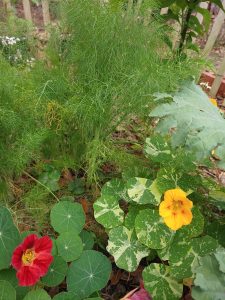Found lacking her sense of urgency, she perused the leaves of eggplant fuzzy with their new growth. Swollen plump, but not quite ripe, tomatoes dripped along stalks, she examines and passes them by. Looking for something fragrant and unique, sampling the mirth of the winter sun, pushing through leaves, and melting the edges of biting breeze, alight at last. A gossamer flutter, steady now, with a pulsing beat as she unfurls and tastes the nectar of purple flowered basil.

The garden at the edge of spring, still full of ripening winter harvest, delicate heads of cabbage, frilly fronds of carrots, the dormant shrubs, and just budding trees. We feel the touch of spring in Florida, quickly and subtly. The fewer flowers blooming now, provide nectar and mirth while we wait for the final harvest of the vegetable garden or ponder our spring plantings.

As we prepare for the changing of the season, our gardens have been providing winter refuge to our pollinator neighbors. A container of Gerber daisies on the porch, a flowering cherry tomato, the white clusters of fragrance on a Walter’s Viburnum, all can provide an over-winter buffet. While the number of pollinators might seem less in the winter, at this the turning point, we see the fattening of caterpillars and the formation of chrysalis.
Bees have been trundling along, maintaining their hives, or harboring their larvae in single nests, beetle larvae have been sleeping in soil and under leaf litter, and other insect pollinators have been meandering through our relatively mild and wet winter. As the days grow a bit brighter, warmer, evenings lose their chill, we will see more of our pollinator friends busy themselves with the work of plant reproduction.
To provide a welcoming respite to pollinators, remember to plant native plants whenever possible, including native milkweeds. Our local and migrating monarch butterfly populations will thank you for your efforts to stop the spread of a deadly disease, OE or Ophryocystis elektroscirrha, a protozoan that can cause deformation and death of monarchs. The protozoan can build up in the non-native Tropical Milkweed (Asclepias curassavica) due to its lack of a dormant season. Cut back your Tropical Milkweed between Halloween and Thanksgiving each year and consider incorporating one or more of the native milkweed varieties.
For more on setting up your own pollinator garden, watch this video:
To further support our native pollinators in your landscape, take these measures:
- Plant a diversity of native flowering plants.
- Provide a complexity of structure, i.e., grasses, shrubs, vines, and trees.
- Make clean water sources available, try a gravel pool: a small dish with stones and water.
- Limit or eliminate your use of insecticides.
For suggestions on host plants and nectar plants, see these IFAS resources:
Nectar Plants, https://sfyl.ifas.ufl.edu/lawn-and-garden/nectar-plants/
Butterfly Gardening in Florida, https://edis.ifas.ufl.edu/publication/UW057
 0
0
